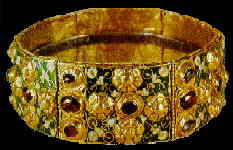| Main | Background | Membership | Activities | Lineages | Contact Us |
The Iron Crown of the first Holy Roman Emperor, Charlemagne, is held in the Cathedral at Monza, near Milan, in Italy. In 1996, Italian scholars asked ANSTO for assistance in accurately establishing the age of the crown in readiness for forthcoming celebrations of the cathedral's 14th centennial. Historical records had placed the age of the crown between the late Roman and middle Ages, a spread of some hundreds of years. Carbon dating is the most accurate means of dating ancient artefacts, but the materials used in the crown - gold, a strip of iron, a nail reputedly from the True Cross, and precious stones - are non-biological and therefore cannot be dated using this technique. During the study of the crown, however, it was discovered that its precious stones were held in place by a mixture of beeswax and clay, a common adhesive of the times. This provided the necessary biological material for nuclear analysis. The solution Samples of less than a milligram were sent to ANSTO for radiocarbon dating at the ANTARES (Australian National Tandem for Applied Research) tandem accelerator. ANSTO's accelerator mass spectrometry team prepared the samples chemically, combusted them and then accelerated the carbon atoms in the tandem accelerator, using a terminal voltage of approximately six million volts. The radiocarbon atoms in the samples were then individually counted, using a particle detector. All living things absorb carbon atoms during their lives, but cease doing so at death. Atmospheric carbon contains a known proportion of the radioisotope carbon 14. This isotope decays and the ratio of carbon to non-radioactive carbon decreases after death at a known rate. By measuring this ratio the age of the sample can be established. Ages of up to 50,000 years can be established using this method. The high precision analysis performed at ANSTO dated the age of the Iron Crown at between 700 and 780 AD. The dating is close to the time in which Charlemagne lived.
ANSTO pinpoints age of Charlemagne's Crown the Australian Nuclear Science and Technology Organization, ANSTO, has used advanced nuclear analysis to definitively date one of Europe's great symbols of power, the Iron Crown of the first Holy Roman Emperor, Charlemagne. The Iron Crown, made of gold and iron and set with precious stones, is held in the Cathedral at Monza, near Milan, in Italy. Cathedral authorities, working with scientists from the Universities of Milan and Genoa, had wished to accurately establish the age of the crown as part of forthcoming celebrations of the cathedral's 14th centennial. Historical records had placed the age of the crown, "between the late Roman and Middle Ages," a spread of some hundreds of years. Carbon dating is the most accurate means of dating ancient artefacts, but the materials used in the crown - gold, a strip of iron, reputedly a nail from the True Cross, and precious stones - are non-biological and cannot be dated using the technique. However, during a recent refurbishment of the crown it was discovered that its precious stones were held in place by a mixture of beeswax and clay, a common adhesive of the times. The necessary biological material was available, but not enough for dating with conventional, non-nuclear, analysis. Minute samples, of less than a milligram each, were sent to ANSTO for analysis in the $5 million tandem accelerator that has established it as a world leader in areas such as ultrasensitive analysis for environmental studies, nuclear safeguards and archaeology. ANSTO's accelerator mass spectrometry team, led by Dr Claudio Tuniz, prepared the samples chemically and combusted them. The carbon atoms of the product were literally counted after being accelerated to 10 per cent of the speed of light using a six million volts electrical field. All living things absorb carbon atoms during their lives, but cease doing so at death. As the rate at which carbon atoms decay is known, if the number of carbon atoms in a sample can be counted, it is possible to calculate its age. Ages up to 50,000 years can be established with the method. The high precision analysis performed at ANSTO dated the age of the Iron Crown at between 700 and 780 AD, making it older than most historical records had indicated. The dating is close to the time in which Charlemagne lived. Charlemagne was crowned the first Holy Roman Emperor, reputedly with the Iron Crown, by Pope Leo III in Rome on Christmas Night, 800 AD. He lived from 742-814 and, as King of the Franks, established and ruled over a kingdom that spanned virtually all the Christian States of western Europe, including what is now France, Switzerland, Belgium, The Netherlands, half of Italy and Germany, part of Austria and a small part of Spain. His role in uniting much of Europe is regarded as having an impact that remains until today. ANSTO's tandem accelerator team is regularly asked to accurately date artefacts for researchers and museums and galleries from around the world. It recently had a lead role in the dating of Aboriginal art galleries from sites throughout Australia.
|

